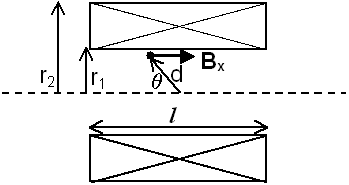Axial Field of a Finite Solenoid

Solenoid in cross section view.

where,
BO is the central field strength of the solenoid,
and the first four even numbered error coefficients, e n, are:
![]()
![]()


where:
![]() ,
, ![]() ,
, ![]() ,
, ![]() ,
, 
![]() ,
, ![]()
r1, r2, and l are inner, and outer coil radii, and coil length, respectively.
d is the distance from the coil center to the field measurement point,
q is the angle between the measurement point position vector and the coil axis,
and the corresponding Legendre polynomials, rn, are:
![]()
![]()
![]()
![]()
where:
![]()

Where r ln are derivatives of the even Legendre polynomials, such as:
![]()
where ![]()
It looks wonderful, except for the fact that the computed radial fields are wrong. I don't know why they're wrong, since the math is a little over my head. If you know the answer, please drop me a line.
SOME USEFUL INFORMATION FOR THE DESIGN OF AIR-CORE SOLENOIDS by D.Bruce Montgomery and J. Terrell., published November, 1961, under Air Force Contract AF19(604)-7344.
Montgomery and Terrell, in turn, credit:
M.W. Garrett, J. Appl. Phys. 22, 9, Sept. 1951.
|
Magnet Formulas web site, © 2005 by
Eric Dennison.
I am developing an updated and expanded version of the magnet web site and encourage you to visit this work in progress and comment on what you see. As a self-employed software engineer trying to balance time between work and magnets, your encouragement in building this site is always welcome!
|
Please consider clicking the PayPal link and making a contribution
to support the maintenance and development of this site. Thank you
for visiting!
| |

